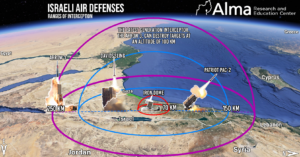On 5 May, Itay Blumenthal, aviation sector correspondent on Israeli news site “Ynet“, published a review analyzing the number of cargo flights between Iran and Syria. This article, including the data presented hereafter, is based on the above review.
The cargo planes flying between Iran and Syria belong to three main entities: Iranian Revolutionary Guards, the Iranian Air Force, and the Syrian Air Force. We estimate that these cargo flights are operated by these three entities, not for the import & export of civilian goods between Iran and Syria, but for operational military purposes, such as transporting military equipment and weapons, Revolutionary Guards, and Army personnel.
3.-> אולי צריך לבדוק מטוסים אחרים, כדוגמת מטוסי הג'מבו של Saha Airlines חברת בת של חיל האוויר האירני ׁׁׁ(EP-SHB EP-SHH) שלעיתים נקלטים מעל עיראק בדרכם לסוריה.
— איתי בלומנטל Itay Blumental (@ItayBlumental) May 5, 2020
שני המטוסים עשו בשנה האחרונה כ-50 טיסות מעל עיראק, בדרך ככל הנראה לסוריה. pic.twitter.com/okNzmjcusO
A subsidiary of the Revolutionary Guards, Qeshm Fars Air, retains two 747-cargo planes operating in the Tehran-Damascus line (aircraft registration: EP-FAA and EP-FAB). Over the past year (May 2019-May 2020), these two aircraft performed 19 flights on the Tehran-Damascus line. If we divide the year into two periods in order to examine a change in the trend, we see that the total number of flights has not been reduced:
From May 2019 to October 2019 incl. (6 months), – a total of 9 flights were made. (7 flights in May 2019, 1 flight in June 2019 and 1 flight in October 2019).
From November 2019 to April 2020 incl. (6 months) – a total of 10 flights were made (3 flights in December 2019, 3 flights in January 2020, 1 flight in February 2020, 1 flight in March 2020, and 2 flights in April 2020).
Also during the writing of this article, on 6 May, Qeshm Fars Air Iranian Jumbo 747 (EP-FAA) owned by the Revolutionary Guards was located in the path for a landing in Damascus, i.e. Revolutionary Guards cargo flights continue constantly with no detection of a decrease in the volume of the flights.
In addition to Qeshm Fars Air jumbo jets (belonging to Revolutionary Guards), two Saha Airlines jumbo aircraft belonging to the Iranian Air Force are also operating (aircraft markings: EP-SHB & EP-SHH). These planes are often picked up on their flight path over Iraq with high likelihood they are on way to or from Syria. These two planes have made 50 flights over Iraq on this route in the past year:
From May 2019 to October 2019 – a total of 33 flights were made (2 flights in May 2019, 3 flights in June 2019, 6 flights in July 2019, 10 flights in August 2019, 7 flights in September 2019 and 5 flights in October 2019).
From November 2019 to April 2020, a total of 17 flights were made (2 flights in November 2019, 6 flights in December 2019, 2 flights in January 2020, 5 flights in February 2020, 1 flight in March 2020 and 1 flight in April 2020).
We know from our knowledge that with the outbreak of the Corona virus crisis, Iran started operating its Air Force jets in order to carry out an “airlift” transporting medical equipment from China to Iran. In our estimation, the decline in flights, particularly in March and April 2020, is due to this reason.
The third party operating cargo flights between Syria and Iran is the Syrian Air Force operating three “Ilyushin” aircraft (aircraft markings: YK-ATA, YK-ATB YK-ATD) The number of Syrian Air Force flights on this route are extremely sizable and amount to dozens of continuous flights over the past year.
In our article, “does the Corona crisis constitute a restraining factor for the Shi’ite military buildup in Syria and Lebanon against Israel?” we stated, that with the outbreak of the crisis last March, there has been some decline in the activities of the Shiite axis in Syria. However, during the month of April, the Shiite elements appear to be back to normal, as these days of crisis present them with an opportunity to promote targeted operational moves in the northern arena. This is evident by the number of airstrikes carried out throughout Syria (As detailed in the article mentioned above). Some of these attacks appear to be scheduled immediately after the arrival of cargo flights from Iran to Syria.
Cargo flights between Iran and Syria continue to be an important pillar in establishing Iran’s grip on Syria. We disagree with the claim expressed in a number of publications, stating that there is a decline in Iran’s presence in Syria. In our opinion, flight and air traffic data as presented in this article do not support this argument (despite a temporary reduction in the number of flights by the Iranian Air Force).
Despite the economic crisis in Iran and in spite of the Corona crisis, Iran continues and will continue to strengthen its hold on Syria.






